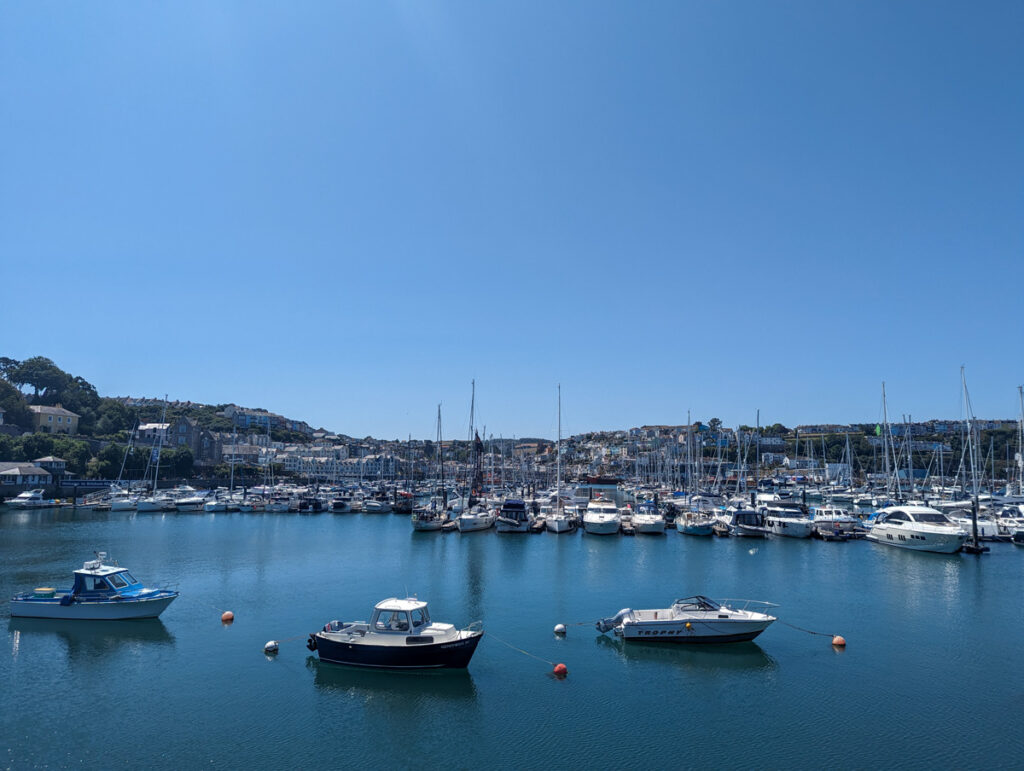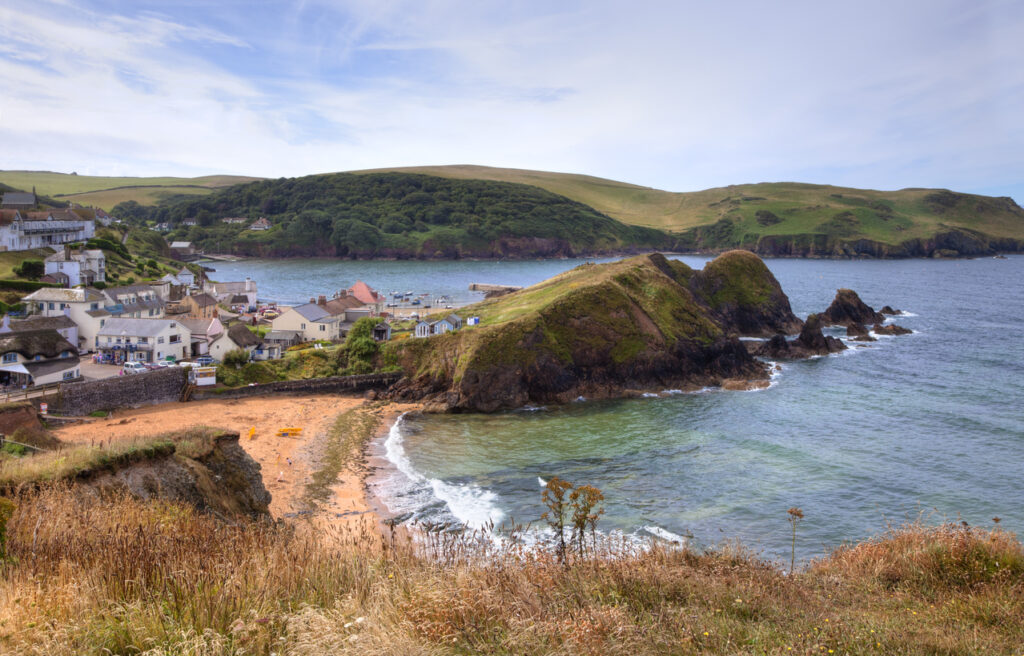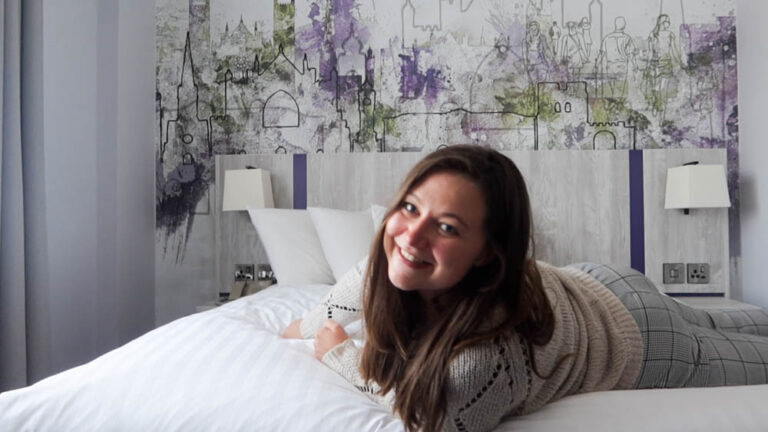13 fishing villages in Devon to visit in 2024
If you’re searching for fishing villages in Devon, look no further!
In Devon, picturesque fishing villages dot the rugged shoreline, offering a glimpse into a bygone era and an authentic taste of maritime charm.
And in Devon’s best fishing villages, traditional cottages stand proudly by the glistening waters, and fishing boats sway gently in the tide.
Discover the traditional fishing cottages spilling down to the harbour of Clovelly, or enjoy vistas of Lynmouth, sitting in the heart of Exmoor National Park.
Explore historic Devonian fishing culture at the enchanting Hallsands or learn about modern fishing in Brixham, home to one of the UK’s biggest fishing fleets.
I’m a Devon local; I live in Exmouth in East Devon, so I’ve frequented all of these villages on a regular basis.
Here are my favourite coastal villages in Devon!
What are the fishing villages in Devon?
Devon’s fishing villages are coastal settlements that historically revolved around the fishing trade.
They’re known for their charming harbours and authentic fishing cottages.
Like the many fishing villages in Cornwall, many of these are nowadays tourist-centric villages.
Most are stunning, but some can be a bit crowded with tourists in the summer season!
However, some villages still maintain active fishing fleets, which is largely different to Cornwall, where most fishing villages are predominantly tourist-focused!
Let’s go into my favourite local fishing villages in Devon.
Best fishing villages in Devon
The best fishing villages in Devon include the privately-owned Clovelly, the charming Appledore (I love its colourful houses!), quaint Lynmouth which is right in Exmoor National Park, tiny Beesands and the enchanting Hallsands which has a fascinating history.
1. Clovelly

Beckoning tourists with an enchanting 19th-century charm, Clovelly sits on the rocky coastline of North Devon.
The privately-owned village, a favourite among tourists, is like a time capsule transporting you back to the 1800s.
Enter through the Visitor Information Centre and stroll down its steep cobbled road, relishing sweeping views of the harbour.
Clovelly’s quaint historic buildings add to its allure, while its small museums offer immersive looks into the lives of 19th century fishermen.
Head down to the harbour, where you can hear seagulls squawking in the salty air, and even walk along the beach to find a small waterfall and cave associated with the legendary birth of Merlin.
As Clovelly’s a privately owned village, there is a charge to enter. Is it worth it? Maybe… it’s an enchanting village, and the charge does cover visiting the town’s museums, but there are other fishing villages in Devon that have the same atmosphere, for free!
Check out all of the best things to do in Clovelly in this blog post.
2. Appledore

Sitting on the banks of the River Torridge, Appledore’s a sleepy North Devon village.
Walk down the famous Irsha Street, lined with pastel-coloured terraces.
Many of these are nowadays Airbnbs, and it can be busy in peak season, but the river-based village offers a distinct charm that’s different to the county’s rocky coastline!
During the summer months, a ferry connects Appledore with Instow, so you can explore the two villages at once.
The South West Coast Path meanders through Appledore as part of the Instow to Westward Ho! Route; it’s a flat section, which makes it a nice easy route (you can also hike this segment).
After a busy day, Appledore invites you to unwind and indulge in its cosy pubs.
Experience the warm hospitality of The Seagate and The Beaver Inn, where you can relish delicious food and drinks in a relaxed setting.
3. Beer

Sitting in the middle of East Devon’s UNESCO World Heritage coastline, Beer’s a charming, relatively isolated fishing village.
The name may attract fans of pints, and while you can have a beer in Beer, the name actually services cack to the Old English word for “grove” or “wooded area.”
Explore the enthralling Beer Quarry Caves, an unmissable attraction in the East Devon area.
These caves take you on a mesmerizing journey through time, unveiling the secrets of the Devon Jurassic Coast and showcasing the famous Beer Stone which has been used in Exeter Cathedral and Winchester Cathedral.
Beer itself is still a working fishing village, with fishing trips for mackerel and the chance to try some local Beer crab.
Or, just stick to the beach and enjoy the UNESCO World Heritage cliffs!
Check out all of the best things to do in Beer in this blog post.
4. Brixham

While Brixham isn’t technically a village, I couldn’t write about fishing settlements in Devon and not include it!
A vibrant coastal town, Brixham is renowned for hosting one of the UK’s largest fishing fleets.
As a bustling working port, Brixham exudes an industrial feeling that sets it apart from other destinations in South Devon.
What does this mean? While it has a different atmosphere from other fishing villages in Devon, there’s tonnes of culture and history to sink your teeth in there.
One of the best things to visit here is the Golden Hind Museum Ship, an impressive replica of Sir Francis Drake’s legendary vessel.
Or, dive into the region’s military past at the Brixham Battery Heritage Centre.
Don’t miss Rockfish; it’s a popular seafood restaurant (with branches in Exeter, Exmouth and elsewhere) that gets their food right here, from Brixham Harbour.
Check out all of the best things to do in Brixham here.
5. Lynmouth

Up in North Devon, in the midst of the breathtaking Exmoor National Park, Lynmouth is a picturesque residence that lies below its sister village, Lynton.
Exmoor Cliffs surround the harbour, where boats bob gently and the cries of seagulls fill the air.
The Lynton to Lynmouth Cliff Railway – nowadays the only remaining water-powered funicular in the country – connects the two villages (and it’s also a really fun way to travel – the views are immense!).
While nowadays, Lynmouth is a peaceful coastal town, it had a tragedy back in 1952; the Lynmouth Flood. Over 9 inches of rain fell within 24 hours, causing rivers to swell and merge, leading to a massive flood that swept through the village.
This disaster resulted in the loss of 34 lives and the destruction of numerous homes and bridges, marking it as one of the most severe floods in British history. You can learn about this at the Lynmouth Flood Memorial Hall.
Take a look at the best things to do in Lynmouth and Lynton here.
6. Instow

Sitting on the banks of the River Torridge, Instow looks over to the more famous Appledore.
Instow is slightly different to some others on this list, as it’s not right on the coast, but life still revolves around the water here thanks to the easy river access.
It’s a small place, just a collection of buildings lined along a quay, but it’s a wonderfully charming place to spend a day or so!
7. Axmouth
Situated near the mouth of the River Axe, not too far from Seaton, Axmouth is a sleepy village in the heart of East Devon, England.
With a population of just 493, Axmouth holds a rich historical legacy. King Alfred the Great who bequeathed the village to his youngest son Aethelweard, as recorded in his will.
By the mid-14th century, Axmouth had earned its reputation as a major port, accounting for an impressive 15% of the country’s shipping trade. This is quite remarkable when you see the miniscule size of the village today!
Today, remnants of its maritime heritage can be witnessed in the form of a remarkably preserved late medieval fishing boat, an iconic relic that emerges at low tide.
The village centre revolves around the striking Church of Saint Michael, and there are also a couple of pubs here.
8. Combe Martin

Combe Martin is a small Devon beach town embraced by a secluded bay, sitting at the Westernmost end of Exmoor National Park.
Holidays in Combe Martin revolve around the pristine beach, which is a paradise for watersports enthusiasts.
For a more relaxed day, bask in the sunshine at the Focsle Inn beer garden and enjoy a local beer or cider!
In the summer months, Combe Martin feels slightly more commercial than some other entries on this list, but it’s a far cry from Devon’s main resort towns like Torquay and Paignton.
Still, there’s lots to do here.
Families can head to the Combe Martin Wildlife and Dinosaur Park, where prehistoric creatures come to life.
Watermouth Castle is also popular – a castle-turned-theme park that guarantees endless fun for all ages.
If you’re visiting without kids, enjoy scenic hikes (I recommend the hike to Ilfracombe – see my guide here) or Exmoor National Park. experiences.
9. Hallsands

Hallsands, a ruined fishing village in Devon, England, is a unique entry on this list!
Founded around 1600, it flourished throughout the 18th and 19th centuries, boasting 37 houses, the London Inn pub, and a population of 159 by 1891.
The residents thrived on fishing, particularly crabbing.
However, the expansion of the naval dockyard near Plymouth in the 1890s led to the disastrous dredging of shingle between Hallsands and Beesands, triggering coastal erosion.
In 1917, a violent storm destroyed the entire village, leaving only one house standing and forcing the villagers to relocate.
Today, the ruins of Hallsands draw in curious tourists, and its compelling story has even been transformed into somewhat of an attraction.
Though the old village site is closed due to erosion, visitors can enjoy views from a viewing platform in the new Hallsands village.
Hallsands beach remains; it’s popular for fishing, swimming, kayaking, snorkeling, and scuba diving.
10. Hope Cove

Head to South Devon for this one!
Situated near Salcombe in the South Hams region of Devon, the roads to Hope Cove may be winding and narrow – but it’s well worth the journey.
Situated within the South Devon Area of Outstanding Natural Beauty (AONB), Hope Cove is a picturesque village that totally captures Devon’s charm.
This tiny haven boasts not one, but two stunning beaches.
Like many spots in Devon, it’s busy in the summer months – but in the winter, you’ll find it gloriously isolated.
Along the coastline, there’s a variety of dining options.
My favourite is The Cove, a pub that serves hearty meals, including vegan fish and chips.
11. Shaldon

While often overshadowed by its neighbors Teignmouth and Torbay, the fishing villlage of Shaldon is laidback and chilled out.
Find quaint fishing boats and rustic architecture in this village, in a fantastic position along the River Teign.
It’s accessible via what is thought to be the oldest ferry in the country (from Teignmouth) or an easy bridge crossing.
Once you’re in town, enjoy a range of eateries, from Cafe ODE to the Ness Inn, visit Shaldon Zoo (one of the more underrated zoos in Exmouth) and walk through a historic smuggler’s tunnel to the hidden beach of Ness Cove.
12. Topsham
Often thought of as a suburb of Exeter, Topsham’s a historic port town that’s well worth adding to your Devon trip.
In fact, Topsham was the UK’s second busiest Port in the 16th century!
Why? It’s thanks to Isabella Fortibus, Countess of Devon in the 12th century. She had some sort of spat with the city of Exeter and took it upon herself to build a Weir over the river Exe to power her own water mills in Topsham.
This move forced Exeter, a thriving woollen cloth hub, to ship its goods to Topsham instead of its own harbour.
For 400 years, this grew Topsham’s wealth, which is evident in its majestic buildings.
Explore the waterfront adorned with historic structures, immerse yourself in the rich heritage showcased at the Topsham Museum, and soak in the authentic fishing culture on the river.
And don’t forget to treat yourself to a delightful lunch at the iconic Globe Pub – or pizza at South West Pizza Co!
When you’re finished, take a train down to Exmouth – not a fishing village, but a lovely coastal town (I live here, so I’m a bit biased!).
13. Branscombe

Saving the best until last!
There’s something that enthralls me about Branscombe in East Devon.
Nestled amidst the breathtaking scenery of the Jurassic Coast, this picturesque haven is adorned with thatched roof cottages.
It’s also home to a cracking cosy country pub, The Masons Arms.
From the village, it’s an easy walk out to the Jurassic Coast beach, where, if you’re lucky, you might just spot a fossil!
It’s a short trek up the cliffs from Branscombe (towards Beer) and you can take in a wonderful view of the beach and village.
Here are all of the best things to do in Branscombe.
Are you ready to visit Devon’s best fishing villages?
With two epic coastlines and countless river estuaries, it’s no surprise that Devon has some of the best fishing villages in England.
Whether you’d like to eat your way around Brixham’s working seafood market, step back in Topsham’s fascinating history or photograph the thatched-roof cottages of Branscombe, Devon certainly delivers when it comes to adorable seaside villages!
Don’t forget to check out the rest of my Devon archives for more information about visiting my home county. And, if you have any questions about visiting Devon (or the rest of South West England), feel free to drop me a message on Instagram – I’m always happy to help!






